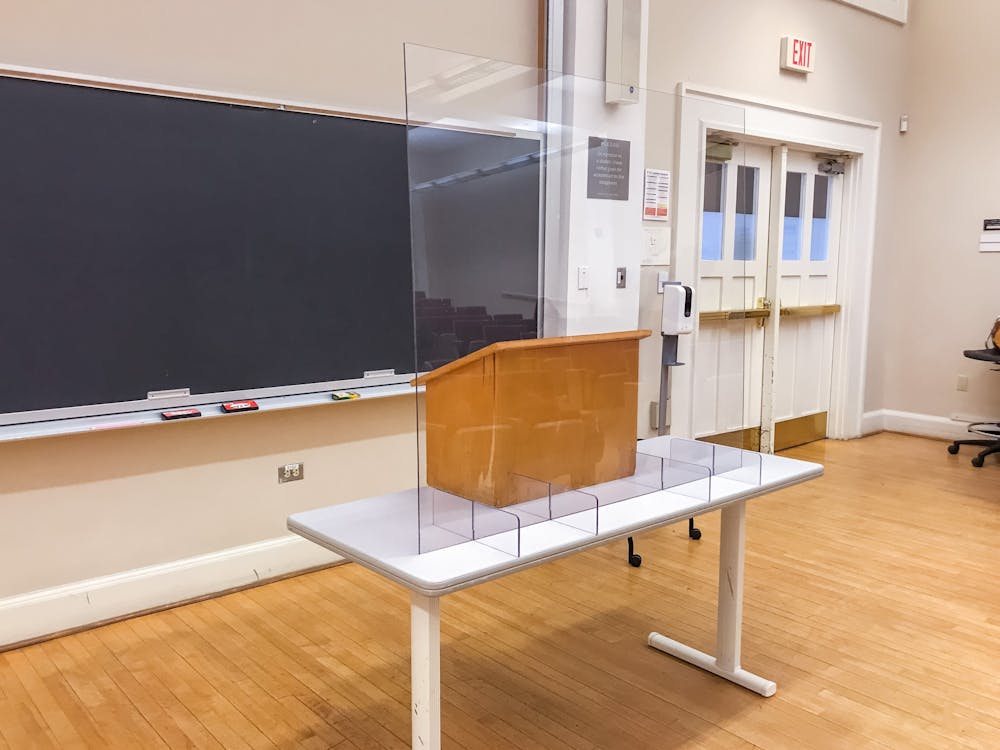Lea en español // 中文版请点击此处
With research indicating that plexiglass screens may not be effective as preventing COVID-19 transmission, students and professors have varying opinions regarding a University policy that permits instructors to lecture without a mask when standing behind a plexiglass barrier.
Most classes returned to in-person instruction this fall with a University mandate in place that requires all students and faculty to wear masks inside any building on Grounds. The University extended the mandate Sept. 2 and now plans to reevaluate the policy before Oct. 1. Per the University’s policy SEC-045, however, "instructors may remove masks when teaching behind plexiglass barriers as long as they can maintain [a] physical distance of at least six feet from students."
According to University spokesperson Wes Hester, the University has focused on risk mitigation using overlapping strategies since the start of the pandemic. Following the implementation of a mandatory vaccination policy, 97 percent of the University’s student body and 96 percent of teaching and research faculty are fully vaccinated — the remaining 3 percent of students are unvaccinated due to exemptions. This vaccination rate — combined with the mandate that all students wear masks during instruction and increased airflow and filtration in University buildings — allowed the University to feel confident in providing the plexiglass option for instructors, Hester said.
“Some professors have found it challenging to teach wearing a mask, which is why we opted to allow an option where professors can teach behind plexiglass as long as they are distanced from students as well,” Hester said. “In using this strategy last year [upon teacher request], we did not have any evidence of classroom transmission.”
Recent research indicates that plexiglass is not as effective of a COVID-19 prevention strategy as once believed. A Centers for Disease Control and Prevention study published in May that looked at transmission prevention strategies in schools concluded that masks and increased ventilation were the most effective at minimizing the spread of COVID-19. Barriers between students proved to be the least effective method tested.
Despite these findings, some professors feel comfortable teaching without masks as permitted by the University. Stanley Stepanic, an assistant professor in the Slavic Languages and Literatures Department, said he believes not wearing a mask improves his SLAV 2360 “Dracula” course.
“It is easier to talk with a mask off, for sure, and I think for students seeing my facial expressions is much different,” Stepanic said. “I'm not an expert on human psychology in that regard, but based on Zoom experiences of the past year and a half, there is simply something more engaging about hearing someone speak in person.”
Stepanic noted that he has not received any complaints from students this year about his decision to not wear a mask while standing behind the plexiglass barrier. Fourth-year Education student Abigail Nita, who is enrolled in Stepanic’s Dracula course, said she prefers her professors to not wear masks.
“It’s so hard to hear them with masks on and the ability to see their facial expressions makes their teaching so much more engaging,” Nita said. “If a student is afraid of a professor not masking, then they can choose to sit further back in the classroom.”
Like many students, Nita said she feels safe with professors teaching behind plexiglass and over six feet away even though she is aware that it may not be as effective at preventing the spread of the virus.
Other professors have continued to wear a mask, even when behind plexiglass. Assist. Biology Prof. Jessamyn Manson said she has chosen to keep her mask on during lectures to ensure the safety of herself and her students.
“A big part of my decision for teaching this particular class is that it’s an active learning class so there’s a lot of group work where I interact one-on-one with students, so I’m not actually spending all my time behind that plexiglass at the podium,” Manson said.
To ensure the best quality of instruction for her students, Manson has opted to use a lightweight mask that is easier to speak through and has chosen to use a microphone even though she is not teaching in a larger lecture hall. Currently, she is recording her lectures as well to make sure that any students who are hearing-impaired will not be disadvantaged.
“I can understand especially in terms of increasing ability to communicate with students why using plexiglass would be a good option for some faculty,” Manson said. “I have some concerns about my ability to communicate with some students through a mask but I decided that my priority is ensuring the safety of my students and the safety of myself and my family.”
Korean lecturer Yesul Han has similar communication concerns in her courses. As a language instructor, Han said that students would benefit enormously from watching how her lips move when pronouncing certain words.
Still, Han said she has chosen to wear a mask to protect herself and her students, especially when she walks around the classroom — something she does frequently in order to make sure that all her students are participating, that they are making progress with their writing and that she can hear all their questions clearly.
“Even though the University provides us with a perspex screen, I have to wear a mask because I cannot be behind the screen all the time and I don’t want my students to be at risk,” Han said.
Mason and Han both noted that they have not received any negative feedback from either students or faculty about choosing to wear a mask. Still, Mason noted that it may be too early for anyone to raise concerns.
“The message I’m getting is that everyone is happy to be back in-person and if there are conditions on that so be it we still get to be here,” Manson said.







